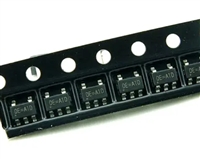www.micropowerdirect.com
PWM Output Current Control
An LED operates at its maximum efficiency when
operated at the rated drive current specified by
the manufacturer. Operating an LED at lower than
its rated forward current not only decreases the
system efficiency; but may cause color (or wave-
length) shifting. In illumination applications, this
could cause visible changes to lighting.
A preferred method is using pulse width modula-
tion (PWM). As shown at left, the output current
is adjusted by applying a PWM signal to the VADJ
input. By varying the signal duty cycle the average
output current is adjusted up or down. To avoid
visible flicker, the PWM signal should be greater
than 200 Hz.
For duty cycles (DPWM) between 0.1 and 1, the
output current is derived by the formula:
PWM Control Signals
INOM IMAX X DPWM
=
The VADJ input may be driven via an open collec-
tor transistor (as shown). The diode and resistor
suppress high amplitude negative spikes that may
be caused by the drain-source capacitance of the
transistor. Negative spikes on the control input of
the unit could cause errors in output current or
erratic operation.
The VADJ input can also be driven by the open drain
output of a microcontroller. Again, any high amplitude
negative spikes that may be caused by the drain-
source capacitance of the FET must be supressed.
PWM Dimming Application
A simple method of achieving digital (or PWM) dimming is by using a 555 timer again. The formulas for calculating the frequency and duty cycle are included
to apply a series of pulses to the VADJ input, as illustrated above. Again, we are
powering the LED driver with the MPM-20S-24EPB AC power supply.
in the MPD application note “Driving LEDs”.
The diodes (D1 and D2) allow duty cycles below 50% to be set. Diode D1
bypasses R2 while C6 is charging. Diode D2 is optional (but recommended),
essentially blocking R2 during the charge period. Theoretically, this circuit will
allow for duty cycles over a range of approximately 5% to 95%. If manual
adjustment is desired, a potentiometer may be substituted for R2 (with some
adjustment of the circuit).
The 555 operates over a supply voltage range of 4.5 VDC to 18VDC. Here it is
connected to the 15 VDC output of the SR7805 switching regulator (also driven
by the MPM-20S-24EPB). Care should be taken to minimize ripple at the VCC
input. Excess ripple could cause timing errors.
The timer is connected for astable (free run) operation. The frequency is set
by R1, R2 and C6. The timing capacitor (C6) charges through R1 and D2. When
it reaches the level of 2/3 VCC, the discharge pin (pin 7) goes low and C6 will
discharge through D1 and R2 to the internal discharge transistor. When the C6
voltage drops to 1/3 VCC, the discharge pin goes high and C6 begins to charge
The size of C6 is generally not critical, but it should be as low leakage as pos-
sible. In order to avoid excessive current flow through the internal discharge
transistor, it is recommended that R1 be at least 5 k⍀.
MicroPower Direct
• 292 Page Street Ste D Stoughton, MA 02072 • TEL: (781) 344-8226 • FAX: (781) 344-8481 • E-Mail: sales@micropowerdirect.com






 一文带你解读74HC244资料手册:特性、应用场景、封装方式、引脚配置说明、电气参数、推荐替代型号
一文带你解读74HC244资料手册:特性、应用场景、封装方式、引脚配置说明、电气参数、推荐替代型号

 AD623资料手册解读:特性、应用、封装、引脚功能及电气参数
AD623资料手册解读:特性、应用、封装、引脚功能及电气参数

 RT9193资料手册解读:RT9193引脚功能、电气参数、替换型号推荐
RT9193资料手册解读:RT9193引脚功能、电气参数、替换型号推荐

 VIPER22A的资料手册解读、引脚参数说明、代换型号推荐
VIPER22A的资料手册解读、引脚参数说明、代换型号推荐
